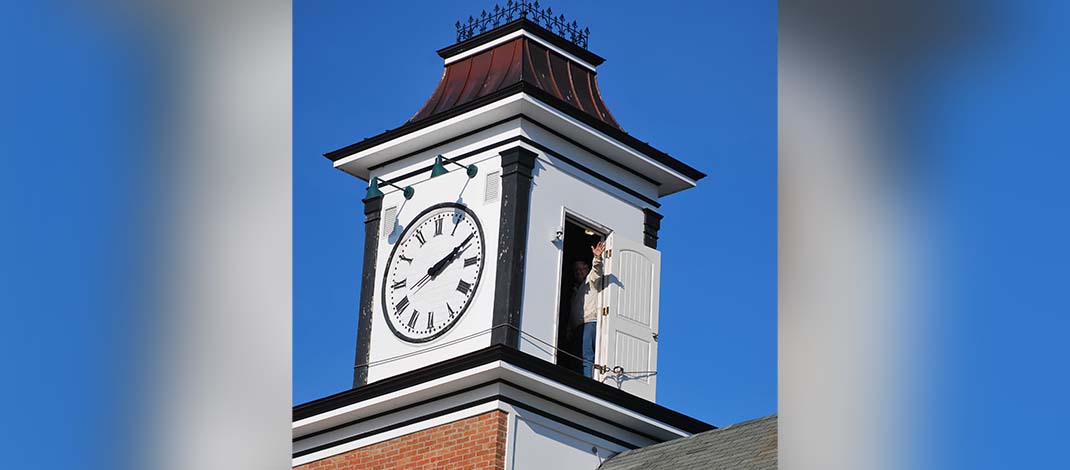A timeless piece of local history, clock was installed in the early 1880s — volunteers over the years made sure it was working properly
By Ken Sturtz
For decades, George Monson appeared at McAuslan Hall each Sunday, making his way up a narrow, creaky flight of stairs to a cramped room at the top of the old brick building.
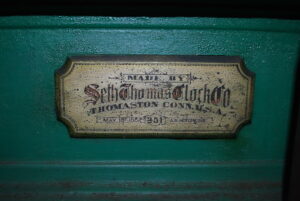
Then he’d spend the better part of an hour resetting the ancient clock and bell, using an 18-inch-long wooden handle to crank the drums to reset the weights, the heaviest of which was more than 300 pounds. The clock took about 30 turns; the bell closer to 200.
“For the clock it wasn’t bad cranking it, but for the striking weight it was tough,” he said. “There were times you’d definitely want to stop and take a breath and then keep going.”
Monson was at the end of a long line of volunteers who set, cared for and occasionally repaired the clock going back to the 1880s.
But it stopped ticking and its bell fell silent several years ago. Faced with the daunting task of repairing a timepiece from another century, the local municipality decided to have the clock and its bell automated.
Regular trips up to the clock tower
When McAuslan Hall was constructed it had no clock or bell. People in the town of Mexico had no suitable meeting place for social and political gatherings. During elections, citizens were forced to cast their ballots at a table set up on Main Street. So in 1877, the townspeople debated building a new town hall. It was a contentious issue, but in the end the building was approved by a mere 73 votes.
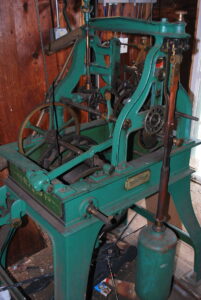
Construction began in 1878 and the building was completed a year later. It wasn’t until a few years after that the town began fundraising for a clock.
In 1882, a clock and bell were ordered from Seth Thomas Co. The cost came to $753.07 plus freight charges of $14.83. Over the years McAuslan Hall served many purposes. It was the town hall, a meeting place and later a movie theater. By the 1970s the local Freemasons had purchased it for their lodge. Jim Emery’s father, Francis Emery, was a member of the lodge and had the responsibility of maintaining and winding the clock.
Emery said his father brought him along a handful of times over the years when he’d wind the clock. The whole thing resembled a giant grandfather clock that stretched the height of the building, Emery said. The clock faces were at the top with the bell. Below that were the clock works and winding mechanism. The weights were connected to cables and ran to the first floor.
“I do know it was a chore so to speak,” he said. “It wasn’t just three or four turns. It took some time to do it.”
In addition to regular trips up to the clock tower to wind the clock, Francis Emery, who died in 2002, also took responsibility for the exterior. He and a friend painted and restored the outside at one point, carefully working on a ledge around the base of the clock.
Francis Emery wound the clock from around 1971 until 1986. Monson remembers noticing one day that the clock had stopped running and asked someone about it. He was told Emery had retired from the volunteer job.
“I said ‘Well who’s going to do it?’” Monson said. “They looked at me and said ‘You.’”
He brushed off the suggestion, but a couple weeks went by and the hands of the clock remained frozen. He realized that the Freemasons hadn’t found a replacement and relented.
Written on a wall in the clock tower Monson found the names of Emery and several of the other people who’d wound the clock over the years. Monson penciled in his name.
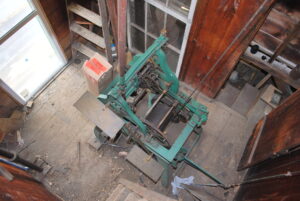
Once a week, ideally Sunday afternoons, Monson entered the women’s bathroom. A door in there led to a flight of stairs that went to an upper floor that once housed the projection booth for the movie theater. He’d unlock another door and climb a set of stairs that was no more than two feet wide. The insulation stopped there, as did the building’s heat. The stairs made a 90-degree turn and after a few more steps he’d be staring at a mass of cables, pulleys and gears. Getting to the bell required climbing a ladder.
“Up to the clock you went,” he said. “And hopefully you’d hear it ticking.”
During summer it was often more than 100 degrees. If there was a particularly bad winter storm, everything in the clock tower would be coated in ice. If it was especially cold or icy out, Monson could actually hear the clock slowing down. Sometimes it would stop altogether.
“It could be temperamental,” he said. “You’d have to troubleshoot the issue.”
Decision to automated clock
Emery taught Monson how to wind and maintain the clock, but by then it was showing signs of wear. It didn’t keep time as accurately as it once had; over the course of a week it would lose time.
Emery told Monson it was necessary to set the clock a few minutes ahead. A week later the clock would have slowed down to where it was supposed to be.
Sometimes Monson could hear noises as the shafts turned, which meant something wasn’t moving smoothly. He’d track down the problem and fine-tune the clock.
“You find out the hard way how picky that thing was,” he says. “If it needed a spot of oil, it would let you know.”
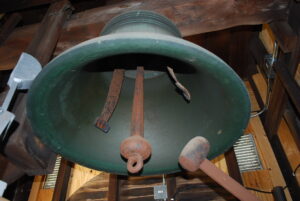
In 2007, Mexico was pummeled with 10 feet of snow, making national headlines. “Good Morning America” weatherman Sam Champion was in town and did a broadcast with the clock tower in the background. The clock was stopped, but because of the record snowfall Monson couldn’t get into the building to wind the clock for days.
Around that time, the town and village purchased the building from the Freemasons, whose numbers had dwindled. The intention was to eventually restore the building and use some of it for office space. Jim Hotchkiss was deputy mayor and represented the village during the process. Monson taught him how to care for the clock and they both began winding it.
While the clock had long needed tweaking to keep it in working order, a larger problem developed in 2015.
The clock tower has faces on three sides. The clockworks powered gears that turned a shaft, which ran up to the clock. The shaft split off in three directions using primitive U-joins to turn the hands on each of the clock faces. A separate shaft powered the bell’s striker.
For a while the hands on one of the clock faces had been causing problems. Sometimes they would be on time; other times they’d be an hour slow.
“The last time I wound it there was something in it jammed up in the works and it wouldn’t let the hands turn anymore,” Hotchkiss said. “It wouldn’t restart when I wound it.”
Town officials were left to figure out what to do. The main problem was finding someone who could fix what was essentially a huge grandfather clock, said Russell Partrick, a town councilor.
“We certainly could have done nothing, but that discussion never came up,” Patrick said. “The discussion for a year and a half was trying to locate somebody to fix it.”
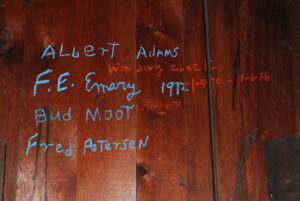
They struggled to find someone with the knowledge or the interest to fix the clock. Just as challenging was finding a replacement for a broken gear. There were no spare parts to be had and it proved nearly impossible to have a gear fabricated in the size needed, Partrick said.
When town officials learned that the school district had recently automated the clock tower on top of the high school, they began exploring the possibility of automating their clock. After a couple months of debate the town board decided to move forward with automation, said Judy Greenway, a town councilor and town historian. The clock tower was too much a part of the community not to save it in some form, she said.
“It was no question we were going to fix it either way,” she said. “We had to do it for the community.”
The town hired a steeplejack and, after a delay due to the pandemic, had the clock automated in March 2021.
$80,000 for the timepiece
Zoltan Zuberecz Sr. has worked as a steeplejack for nearly 40 years. His family business Highclimbers Company, based in Pottstown, Pennsylvania., works on smokestacks and steeples. They also demolish, refurbish and automate clock towers.
He says customers sometimes have the bell removed so it can be displayed on the ground. Other times the bell is replaced by a speaker system that recreates the sound of bells. In the case of McAuslan Hall, the bell was stationary and in good shape so they installed an electric striker.
Once electric service was installed, Zuberecz and his son replaced the hands on each clock face. The old shafts and gears were replaced with electronic controllers. The bell and the clock are connected to a computer system that keeps perfect time. They can control how often the bell tolls and there’s even a backup system if the power goes out.
With the clock and bell automated, Monson and Hotchkiss no longer climb up to the clock tower each week to wind the clock.
“It’s too bad they didn’t leave it the way it was and get it repaired,” Hotchkiss said. “Fortunately, they didn’t sell the clock works.”
The clock works are still up there. Hotchkiss says a museum in Pennsylvania offered the Freemasons $80,000 for the timepiece, but they wanted it to stay in Mexico. The local historical society has offered to display it.
“Something as unique and special as that deserves to be preserved as much as it can be,” Monson said. “A digital clock doesn’t cut it.”
If it’s disappointing to see the old clock go, Hotchkiss said it’s also nice to see it working once again. He and Monson say the only discernible difference between the original clock and the automated system is that the bell doesn’t toll as loudly as it once did.
When Monson wrote his name on the wall of the clock tower years ago, he also wrote the date he began winding the clock. But he never wrote an end date. Now he said he’s just grateful he got to be part of a unique piece of history.
“It’s kind of humbling,” he said. “It’s something I never asked for, never expected to do and it just kind of fell into my lap.”

